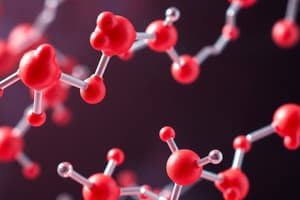Podcast
Questions and Answers
What is one method bacteria use to develop resistance against antibiotics?
What is one method bacteria use to develop resistance against antibiotics?
- Enhancing metabolic pathways
- Efflux pumps (correct)
- Increasing nutrient absorption
- Reducing growth rate
Which mechanism of resistance involves the direct transfer of plasmid DNA between bacteria?
Which mechanism of resistance involves the direct transfer of plasmid DNA between bacteria?
- Transformation
- Conjugation (correct)
- Mutation
- Transduction
What happens when bacteria produce enzymes that degrade antibiotics?
What happens when bacteria produce enzymes that degrade antibiotics?
- They become more susceptible to antibiotics.
- They increase the effectiveness of the antibiotic.
- They stop reproducing.
- They become resistant to antibiotics. (correct)
What defines the process of transformation in bacterial resistance spread?
What defines the process of transformation in bacterial resistance spread?
In what order are bacteria typically affected when exposed to antibiotics?
In what order are bacteria typically affected when exposed to antibiotics?
What is the primary role of bioinformatics in the identification of pathogens?
What is the primary role of bioinformatics in the identification of pathogens?
Which step in the DNA identification process involves breaking down bacterial cell walls?
Which step in the DNA identification process involves breaking down bacterial cell walls?
What is the function of primers during the DNA sequencing process?
What is the function of primers during the DNA sequencing process?
What does 'Patient Zero' refer to in the context of an outbreak?
What does 'Patient Zero' refer to in the context of an outbreak?
What is PCR primarily used for in the process of identifying pathogens?
What is PCR primarily used for in the process of identifying pathogens?
What is the primary purpose of performing a serial dilution?
What is the primary purpose of performing a serial dilution?
Which step in the ELISA process involves the detection of the antigen?
Which step in the ELISA process involves the detection of the antigen?
What structural feature of Gram-positive bacteria is significantly greater than in Gram-negative bacteria?
What structural feature of Gram-positive bacteria is significantly greater than in Gram-negative bacteria?
How do penicillins function as antibiotics?
How do penicillins function as antibiotics?
What is the purpose of placing a control disk in an antibiotic effectiveness test?
What is the purpose of placing a control disk in an antibiotic effectiveness test?
In which of the following ways do sulfonamides exert their effect against bacteria?
In which of the following ways do sulfonamides exert their effect against bacteria?
What happens to bacteria during the formation of superbugs?
What happens to bacteria during the formation of superbugs?
Which factor determines the antibiotic with the highest effectiveness in an antibiotic susceptibility test?
Which factor determines the antibiotic with the highest effectiveness in an antibiotic susceptibility test?
Which component of the bacterial structure assists in the transfer of DNA between bacteria?
Which component of the bacterial structure assists in the transfer of DNA between bacteria?
What does a positive result for disease antigens in an ELISA test typically indicate?
What does a positive result for disease antigens in an ELISA test typically indicate?
Overall, what is a consequence of the introduction of antibiotics in medicine?
Overall, what is a consequence of the introduction of antibiotics in medicine?
What is the primary role of the capsule in harmful bacteria?
What is the primary role of the capsule in harmful bacteria?
Which class of antibiotics is known for preventing the translation of mRNA into proteins?
Which class of antibiotics is known for preventing the translation of mRNA into proteins?
Flashcards
Patient Zero
Patient Zero
The first person infected in an outbreak, who often unknowingly spreads it to others.
Bioinformatics
Bioinformatics
The use of computers and databases to analyze biological data, like DNA sequences, to identify pathogens.
PCR (Polymerase Chain Reaction)
PCR (Polymerase Chain Reaction)
A process that makes many copies of a specific DNA region, allowing for analysis and identification of pathogens.
BLAST (Basic Local Alignment Search Tool)
BLAST (Basic Local Alignment Search Tool)
Signup and view all the flashcards
Atomic concepts
Atomic concepts
Signup and view all the flashcards
Mutation
Mutation
Signup and view all the flashcards
Efflux Pumps
Efflux Pumps
Signup and view all the flashcards
Antibiotic Destruction/Inactivation
Antibiotic Destruction/Inactivation
Signup and view all the flashcards
Conjugation
Conjugation
Signup and view all the flashcards
Transformation
Transformation
Signup and view all the flashcards
Serial Dilution
Serial Dilution
Signup and view all the flashcards
ELISA (Enzyme-Linked Immunosorbent Assay)
ELISA (Enzyme-Linked Immunosorbent Assay)
Signup and view all the flashcards
Solute
Solute
Signup and view all the flashcards
Solvent
Solvent
Signup and view all the flashcards
Original Concentration
Original Concentration
Signup and view all the flashcards
Tube Dilution
Tube Dilution
Signup and view all the flashcards
Final Dilution
Final Dilution
Signup and view all the flashcards
Capsule (Bacterial Structure)
Capsule (Bacterial Structure)
Signup and view all the flashcards
Cell Wall (Bacterial Structure)
Cell Wall (Bacterial Structure)
Signup and view all the flashcards
Plasma Membrane (Bacterial Structure)
Plasma Membrane (Bacterial Structure)
Signup and view all the flashcards
Nucleoid (Bacterial Structure)
Nucleoid (Bacterial Structure)
Signup and view all the flashcards
Pili (Bacterial Structure)
Pili (Bacterial Structure)
Signup and view all the flashcards
Plasmids (Bacterial Structure)
Plasmids (Bacterial Structure)
Signup and view all the flashcards
Ribosomes (Bacterial Structure)
Ribosomes (Bacterial Structure)
Signup and view all the flashcards
Flagella (Bacterial Structure)
Flagella (Bacterial Structure)
Signup and view all the flashcards
Gram-Positive Bacteria
Gram-Positive Bacteria
Signup and view all the flashcards
Gram-Negative Bacteria
Gram-Negative Bacteria
Signup and view all the flashcards
Study Notes
Medical Interventions
- Medications: Ibuprofen, Tylenol, antidepressants
- Hygiene: Soap, hand sanitizer, toothpaste
- Physical Treatment: (no specific examples given in the text)
Patient Zero
- First person to become sick in an outbreak
- Possesses the highest concentration of the disease antigen
- Epidemiologists use samples, bioinformatics (BLAST), and patient interviews to identify Patient Zero and track disease spread.
- Quarantine and treatment of infected individuals is essential.
Using DNA to Identify Pathogens
- Bioinformatics combines biology, computers, and information technology to store and analyze genetic data.
- The Human Genome Project mapped the human genome, aiding pathogen identification.
- Bioinformatics compares patient pathogens to known databases.
- DNA identification steps include sample preparation, PCR amplification, purification, sequencing preparation, DNA sequencing, and sequence analysis using BLAST.
Serial Dilutions
- Used to determine the amount of disease antigen present in a sample.
- Creates samples with varying concentrations.
- Dilution calculations involve solute, solvent, and solution.
- Formulas are provided for tube dilution and final dilution.
- Concentration is calculated based on the original concentration and final dilution.
- Used in ELISA to identify Patient Zero through comparison of antigen concentrations in patient samples.
ELISA
- Enzyme-Linked Immunosorbent Assay uses antibody tagging and enzyme reactions to produce visible color changes.
- Qualitative results show whether a patient has a specific antigen or antibody.
- Quantitative results measure the amount of detected substance.
- Data helps trace the chain of infection.
- Serial dilutions are used to produce samples with varying antigen concentrations.
- Comparison of sample concentration to a concentration strip identifies the patient with the highest antigen concentration (Patient Zero).
- ELISA steps outline the process of detecting antigens or antibodies in a sample.
Bacterial Structures
- Capsule: Protective layer (found in more harmful species)
- Cell Wall: Second outer layer, provides shape and contains endotoxins.
- Plasma Membrane: Controls molecule passage.
- Nucleoid: Contains bacterial DNA.
- Pili: Hair-like structures for attachment and DNA transfer (conjugation).
- Plasmids: Circular DNA exchanged via pili; the only form of DNA that can be exchanged.
- Ribosomes: Produce proteins.
- Flagella: Used for movement.
- Gram-Positive Bacteria: Thicker cell walls, stain blue/purple, generally considered less dangerous.
- Gram-Negative Bacteria: Thinner cell walls, stain red/pink, often more dangerous.
Classes of Antibiotics
- Antibiotics are substances derived from microorganisms that inhibit or kill bacteria.
- Different antibiotic classes target different bacterial processes, leading to varying antibiotic effects.
Antibiotic Effectiveness and Uses
- Testing antibiotic effectiveness involves creating zones of inhibition around antibiotic disks placed on petri dishes with bacteria.
- The largest inhibition zones indicate the most effective antibiotics.
Superbugs Lab: Developing & Spreading Antibiotic Resistance
- Antibiotic resistance develops from mutations, mutations involving efflux pumps and enzyme inactivation.
- Resistance genes are shared through conjugation, transformation, and transduction.
- Conjugation transfers plasmids.
- Transformation involves bacteria picking up free plasmids.
- Transduction involves bacteriophages transferring DNA.
When Antibiotics Fail
- Bacteria are categorized as least resistant to most resistant with weakest bacteria being susceptible to killing first.
Studying That Suits You
Use AI to generate personalized quizzes and flashcards to suit your learning preferences.




